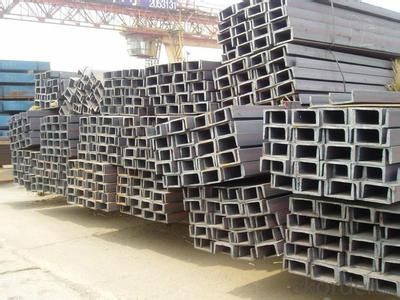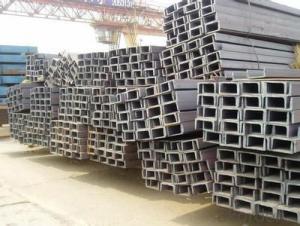Galvanized and Stainless Steel Channel Steel
- Loading Port:
- Tianjin
- Payment Terms:
- TT OR LC
- Min Order Qty:
- 2000 PCS
- Supply Capability:
- 38000 PCS/month
OKorder Service Pledge
OKorder Financial Service
You Might Also Like
Galvanized and Stainless Steel Channel Steel
Standard: | AISI,ASTM,BS,DIN,GB,JIS | Dimensions: | Standard and nonstandard. | Grade: | As your order. |
Place of Origin: | China (Mainland) | Brand Name: | BOCHI | Perforated Or Not: | Not Perforated |
Shape: | Both U and C type. | Application: | Construction | Paint: | We can paint as order. |
Packaging & Delivery
Packaging Detail: | By bundle and tied with steel strips. |
Delivery Detail: | 15-35 days after receiving deposit. |
Galvanized and Stainless Steel Channel Steel Specifications
1.Standard and nonstandard are provide.
2.Material can as order.
3.Quality ensure.
4.Best after-sell service.
Galvanized and Stainless Steel Channel Steel Features
1.Material from famous steelworks,such as Baosteel,Wuhan steel,etc.
2.We have advanced technology.
3.Special specifications are available.
4.Welcome you inspection before delivery.
5.ISO9001,TS16949,AS9100,DNV,CCS and other classification society certificate is available.
6.Reasonable price and best after-sell service.
Galvanized and Stainless Steel Channel Steel Pictures


- Q:How do steel channels contribute to the overall aesthetics of a building?
- There are several ways in which steel channels can enhance the aesthetics of a building. Firstly, their modern and contemporary design adds a stylish and cutting-edge element to the structure. The clean lines and precise edges of steel channels create an attractive appearance, elevating the overall aesthetic appeal of the building. Moreover, steel channels offer a wide range of design possibilities, allowing for the creation of unique and intricate patterns that add visual interest to the building's facade. Whether used horizontally, vertically, or diagonally, steel channels provide an outlet for creative expression, enabling architects and designers to craft striking and captivating architectural features. Additionally, steel channels can be finished in various ways to complement the building's overall design concept. They can be painted in different colors, creating a bold or subtle contrast with the surrounding materials. Alternatively, steel channels can be left exposed, showcasing their natural metallic finish, which adds a touch of industrial elegance to the building's aesthetic. Furthermore, the durability and long-lasting nature of steel channels not only benefit the structure's stability but also contribute to its overall aesthetics. The longevity of steel channels ensures that the building maintains its visual appeal for years to come, without the need for frequent repairs or replacements. In conclusion, steel channels enhance the aesthetics of a building by adding a sleek and modern touch, offering versatile design options, allowing for various finishes, and providing durability. Their ability to enhance the visual appeal of a structure makes them a favored choice among architects and designers seeking to create aesthetically pleasing buildings.
- Q:Can steel channels be used for bridge construction?
- Yes, steel channels can be used for bridge construction. Steel channels are commonly used as structural components in bridge construction due to their high strength, durability, and versatility. They provide excellent load-bearing capacity and can be easily fabricated into various shapes and sizes to meet the specific requirements of the bridge design.
- Q:Are steel channels suitable for soundproofing?
- Typically, steel channels are unsuitable for soundproofing. Although they are commonly utilized for structural support in construction, they do not excel at blocking or absorbing sound. Steel, being dense and rigid, tends to reflect sound waves rather than absorb them. To attain effective soundproofing, it is generally recommended to employ materials with high sound absorption properties, such as acoustic foam or mass-loaded vinyl. These materials aid in reducing sound transmission and have the potential to create a more soundproof environment.
- Q:What are the common material testing procedures for steel channels?
- Common material testing procedures for steel channels include tensile testing, hardness testing, impact testing, and dimensional inspection. Tensile testing involves pulling a sample of the steel channel until it breaks to determine its strength and ductility. Hardness testing measures the resistance of the steel to indentation or scratching, providing an indication of its overall toughness. Impact testing assesses the steel's ability to withstand sudden, high-force impacts. Dimensional inspection ensures that the steel channels meet the required size and shape specifications.
- Q:Do steel channels have any specific deflection limitations?
- Steel channels do indeed have specific limits on deflection. The deflection of steel channels, along with other structural members, is influenced by factors such as their material properties, dimensions, and the loads they experience. Building codes and industry standards usually specify the maximum allowable deflection for steel channels. These limits are established based on the concept of serviceability, which ensures that the structure remains functional and safe during normal operation. The deflection restrictions for steel channels can vary depending on the particular application and loading conditions. For instance, in the design of structural steel, the deflection limits for beams and columns typically depend on the ratio of span to depth or a predetermined maximum deflection value. Engineers also take into account factors like the intended use, aesthetic considerations, and occupant comfort when determining deflection limitations. For example, in buildings where sensitive equipment or occupant comfort could be affected by vibrations or excessive deflections, stricter deflection criteria may be applied. To determine the specific deflection limitations for steel channels in a given situation, it is important to refer to relevant building codes, industry standards, and engineering guidelines. Professional structural engineers are responsible for ensuring that the design meets these requirements to guarantee the safety and performance of the structure.
- Q:Are steel channels suitable for modular construction practices?
- Yes, steel channels are suitable for modular construction practices. Steel channels are commonly used in modular construction due to their versatility, strength, and ease of installation. They provide structural support and can be easily assembled and disassembled, making them ideal for modular construction where flexibility and efficiency are key.
- Q:Are steel channels suitable for stadium construction?
- Yes, steel channels are suitable for stadium construction. Steel channels are commonly used in construction projects, including stadiums, due to their strength, durability, and versatility. They provide structural support and stability to the overall building, making them an ideal choice for large-scale projects like stadiums. Additionally, steel channels can be easily customized and fabricated to meet specific project requirements, allowing for flexibility in design and construction. They are also resistant to corrosion and can withstand heavy loads and extreme weather conditions, ensuring the long-term integrity and safety of the stadium. Therefore, steel channels are a reliable and efficient choice for stadium construction.
- Q:Can steel channels be used for creating signage or display structures?
- Indeed, signage or display structures can be fashioned using steel channels. These channels, due to their versatility and durability, are appropriate for a multitude of purposes, including signage and display structures. Their robustness and inflexibility enable the construction of resilient frameworks that can endure harsh outdoor conditions and substantial burdens. Furthermore, steel channels can be effortlessly personalized and manufactured into diverse configurations and dimensions, thus catering to particular design prerequisites. Consequently, they represent an exemplary option for crafting extraordinary and attention-grabbing signage or display structures.
- Q:How do steel channels perform in high-load applications?
- Steel channels perform exceptionally well in high-load applications. Due to their sturdy construction and high strength-to-weight ratio, they can effectively bear heavy loads without deformation or failure. Additionally, the structural integrity of steel channels ensures long-term durability, making them an ideal choice for high-load applications where reliability is crucial.
- Q:What are the weight calculations for steel channels?
- To determine the weight of steel channels, one can utilize the following formula: Weight can be found by multiplying the cross-sectional area with the density of steel. The cross-sectional area of a steel channel can be determined by multiplying the width (W), height (H), and thickness (T) of the web. In the case of tapered flanges, the average width (Wa) of the flanges should be employed. To calculate the cross-sectional area, add twice the average width of the flanges to the width, multiply the sum by the height, and add the product of the thickness and width. The density of steel typically measures approximately 7,850 kilograms per cubic meter (kg/m³). Hence, the weight of the steel channel can be established by multiplying the cross-sectional area by the density of steel. To ensure accurate weight calculations, it is crucial to employ consistent units for all measurements, such as meters or millimeters. Additionally, it is advisable to verify the specific dimensions and specifications of the steel channel being utilized, as they may vary.
1. Manufacturer Overview |
|
|---|---|
| Location | |
| Year Established | |
| Annual Output Value | |
| Main Markets | |
| Company Certifications | |
2. Manufacturer Certificates |
|
|---|---|
| a) Certification Name | |
| Range | |
| Reference | |
| Validity Period | |
3. Manufacturer Capability |
|
|---|---|
| a)Trade Capacity | |
| Nearest Port | |
| Export Percentage | |
| No.of Employees in Trade Department | |
| Language Spoken: | |
| b)Factory Information | |
| Factory Size: | |
| No. of Production Lines | |
| Contract Manufacturing | |
| Product Price Range | |
Send your message to us
Galvanized and Stainless Steel Channel Steel
- Loading Port:
- Tianjin
- Payment Terms:
- TT OR LC
- Min Order Qty:
- 2000 PCS
- Supply Capability:
- 38000 PCS/month
OKorder Service Pledge
OKorder Financial Service
Similar products
New products
Hot products
Related keywords



























